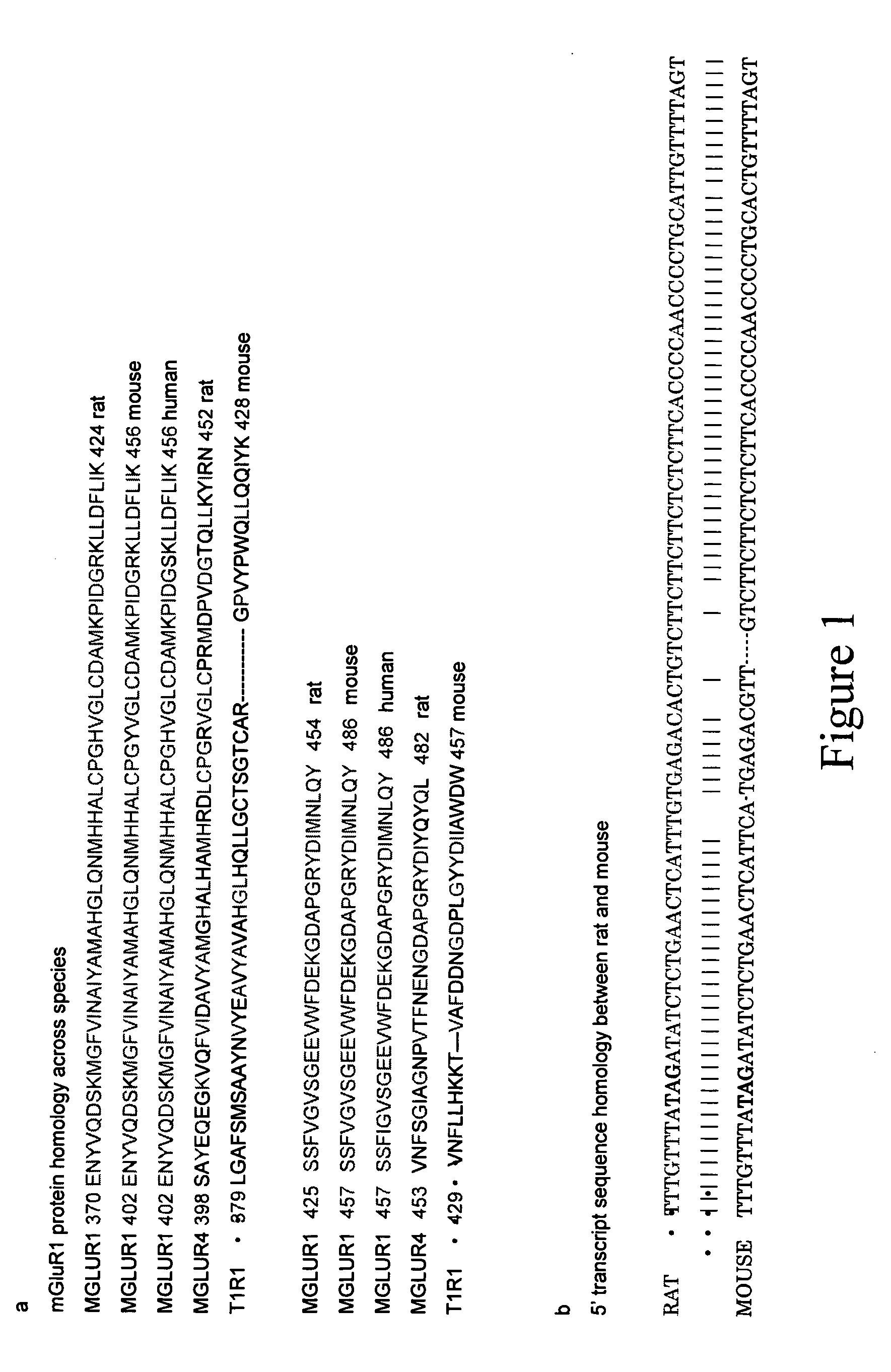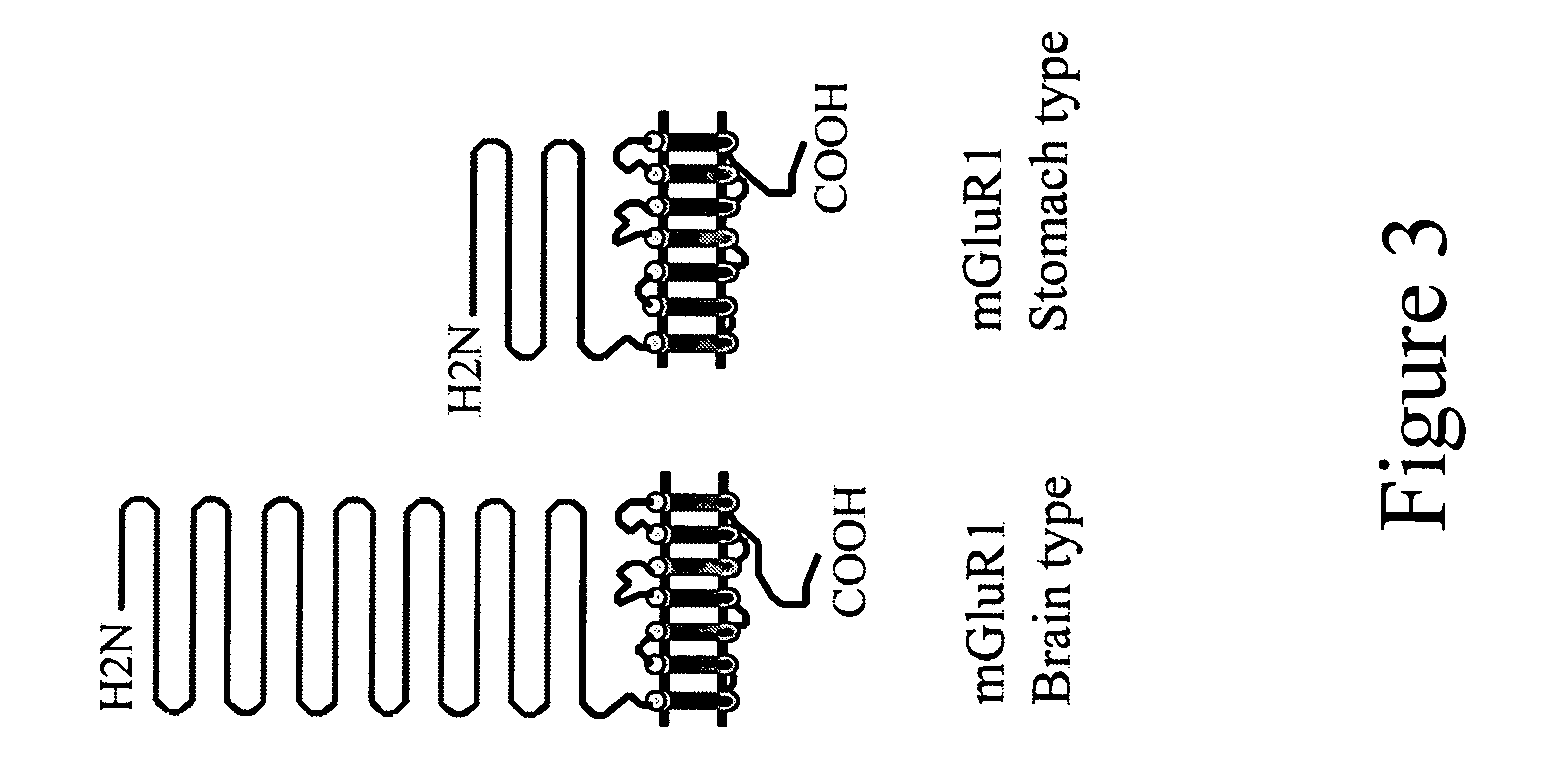Novel glutamate receptors and utilization thereof
a glutamate receptor and receptor technology, applied in the direction of peptides, drug compositions, cardiovascular disorders, etc., can solve the problems of preventing the progress in this research field, no recent work progress, unclear glutamate perception,
- Summary
- Abstract
- Description
- Claims
- Application Information
AI Technical Summary
Benefits of technology
Problems solved by technology
Method used
Image
Examples
example 1
Cloning of Novel Metabotropic Glutamate Receptor cDNA from Circumvallate Papillae of Rat
[0141] Total RNA derived from circumvallate papillae of ten rats of Wistar strain of 16 weeks age were extracted and subjected to a reverse transcription reaction to give cDNA (kit used: SuperScript, Gibco-BRL). cDNA coding for full length of mGluR1 was used as a template and a PCR was carried out by Z-Taq. This enzyme has a good replication efficiency at 3′-side and is suitable for a TOPO TA cloning reaction after that. The PCRproductwas subjected to electrophoresis using 2% agarose gel and the sequences were analyzed by an ABI Sequencer Model 3100 (ABI Co., Ltd.).
[0142] Taste mGluR1β type A was cloned from circumvallate papillae, with unique sequence at 5′-side Forward primers specific to mGluR1β type A variant cDNA prepared by Hokkaido System Science; the primers used are shown in Table 1. The following reverse primers were prepared from brain type mRNA sequence (mGluR1-4253R 5′-TAC CAT ATG ...
example 2
In Situ Hybridization of Stomach mGluR1
[0145] Rat stomach mucosa was prepared as described previously (Hoshino et al., 1999, and Yoshida et al., 2001). Hybridization was performed with probes at concentrations of 200-500 ng / ml in a hybridization solution (50% formamide, 5×SSC, 1% SDS, 50 μg / ml tRNA, and 50 μg / ml heparin) at 55° C. for 16 h. Antisense probes with nucleotide sequence common to all mGluR1 variants (SEQ ID NO: 17) were labeled with digoxigenin and sections incubated with anti digoxigenin alkaline phosphatase conjugate antibodies (Roche Molecular Biochemicals). Signals were developed with BM purple substrate (Roche Molecular Biochemicals).
[0146] As a result, in situ hybridization this analysis revealed that the stomach cells that contain mGluR1 transcripts are: neck mucous, chief and parietal cells as shown in the pictures of the left side FIG. 4 using an mGluR1 anti-sense probe.
EXAMPLE 3
Cloning of Novel Metabotropic Glutamate Receptor cDNA from Stomach of Rat
[0147]...
example 3
[0158] cRNA synthesis. The resulting pcDNA3.1 / V5-His vector was used as a template to synthesize the corresponding stomach and brain mGluR1 cRNA. Target DNA was amplified again with pfu DNA polymerase enzyme (Promega, USA) including the T7 promoter sequence (T7 PCR Forward primer 5′-TATTTAATACGACTCACTATAGGATAAGCATAACAGGGAATTGCAGTGG-3′; SEQ ID NO: 13) with the reverse primer mGluR1-4198R (SEQ ID NO: 11). Capped RNA was synthesized with a T7 transcription kit (mMessage mMachine, Ambion, USA). Reaction mixture was incubated for 2 hours at 37° C. for complete RNA synthesis and remaining template DNA was degraded by adding 1 mL of DNase 1 during 15 minutes. Transcripts were purified by phenol-chloroform extraction and isopropanol precipitation. cRNA was reconstituted in diethyl pyrocarbonate-treated (DEPC) water and quantitated by UV light absorbance before oocyte injection.
[0159] Oocyte injection. Twenty-four hours after collection, healthy Xenopus oocytes retaining...
PUM
| Property | Measurement | Unit |
|---|---|---|
| Temperature | aaaaa | aaaaa |
| Fraction | aaaaa | aaaaa |
| Composition | aaaaa | aaaaa |
Abstract
Description
Claims
Application Information
 Login to View More
Login to View More - R&D
- Intellectual Property
- Life Sciences
- Materials
- Tech Scout
- Unparalleled Data Quality
- Higher Quality Content
- 60% Fewer Hallucinations
Browse by: Latest US Patents, China's latest patents, Technical Efficacy Thesaurus, Application Domain, Technology Topic, Popular Technical Reports.
© 2025 PatSnap. All rights reserved.Legal|Privacy policy|Modern Slavery Act Transparency Statement|Sitemap|About US| Contact US: help@patsnap.com



